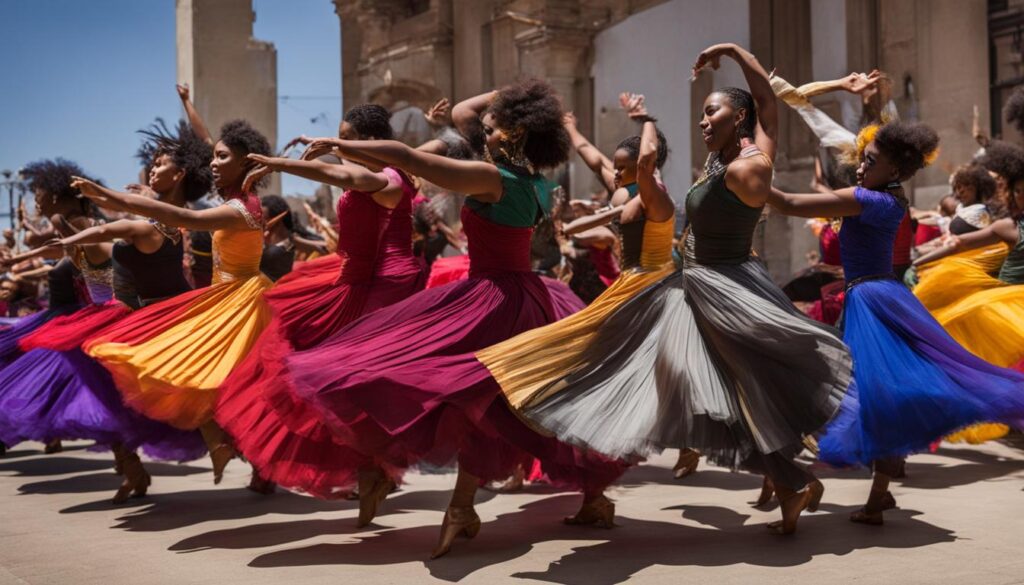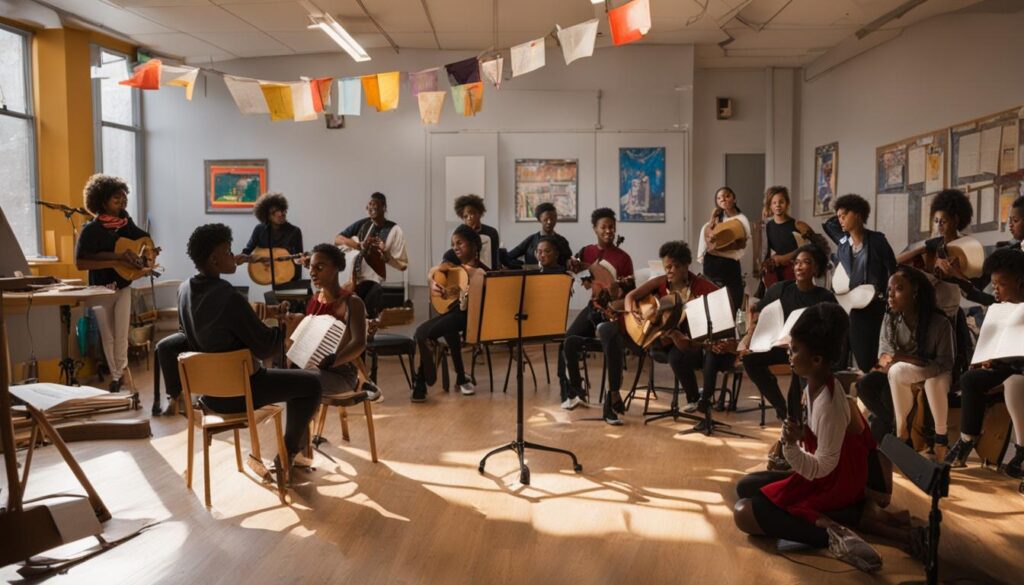Have you ever found yourself completely immersed in a live performance, where the vibrancy of theater arts unfolds before your very eyes? I have, and it’s moments like these that define the allure of performing arts. The performing arts definition encompasses creative expressions where artists share their narratives, emotions, and cultural embodiments in front of a live audience. From the dramatic crescendos in music performances to the expressive storytelling of dance performances, the spectrum of performing arts is endlessly captivating.
Every time I witness these art forms, the sheer energy and passion transcend beyond the ordinary, creating an irreplicable moment in time. Whether it be the echo of a powerful note in a concert hall or the precise movement of a ballerina’s pirouette, examples of performing arts like these leave a lasting impression that embodies the beauty of human creativity and connection. Now let’s dive in and explore the ocean of artistry that keeps our culture pulsating with life and vibrancy.
Key Takeaways
- The performing arts are a dynamic and interactive form of creative expression.
- Theater arts release stories onto the stage, captivating audiences with vivid storytelling.
- Dance performances communicate deep narratives through choreographed movements.
- Music performances range from solo instrumental pieces to grand orchestral ensembles.
- Live performance is an integral avenue for cultural expression and connection.
- Examples of performing arts showcase the rich diversity and talent found across the globe.
- Engaging in the performing arts can be a transformative experience that echoes the core of our shared humanity.
Defining the World of Performing Arts
As a performing arts enthusiast, the vibrancy and diversity of this field never cease to amaze me. The vast array of types of performing arts and performing arts genres cover a spectrum of creative expression, each with its unique charm and complexity. Let’s dive into the rich world of theatre, music, opera, and ballet, and ponder the cultural impact they have.
From Theatre to Music: Diversity in Artistic Expression
Theatre is where words, gestures, and visual finesse coalesce to tell compelling stories. Be it the allure of a Broadway musical or the spontaneity of improvisational theatre, each performance is an invitation to a different world. Music, on the other hand, offers a rich tapestry of sound, from the intricate compositions of classical symphonies to the soulful outpourings of blues and the rhythmic beats of pop.
Not Just a Performance: The Cultural Impact of the Arts
The resonance of performing arts goes beyond mere entertainment. Opera, with its grand narratives and emotive arias, holds a mirror to human emotion and societal norms. Ballet’s disciplined, ephemeral beauty often tells a wordless story, reflecting centuries of artistic evolution. The true essence of performing arts lies in their power to crystallize and shape our cultural heritage, marking significant moments in the story of humanity, across all civilizations.
- Theatre: A blend of storytelling and spectacle
- Music: Harmonies that resonate with our essence
- Opera: Dramatic narratives that stir the soul
- Ballet: Precision and grace narrating timeless tales
Exploring these genres reminds us of the inextricable link between the arts and the cultural conversations that define our communities. I see the arts as both a participant and a progenitor of cultural dialogue, shaping and reflecting our shared experiences.
The Roots of Performance: A Historical Perspective
As I delve into the rich tapestry of the history of performing arts, it’s impossible not to feel a profound connection to the past. The origins of performance are entwined with the very fabric of human expression and societal evolution. Today, I’m taking you on a journey that spans millennia, retracing the artistic footsteps that have led us to the modern stage.
Tracing Back to the Classics: Greek Tragedy and Roman Farce
In the sun-kissed amphitheaters of ancient Greece, the roots of Western drama took hold. The Greek tragedy, with its grandiose tales of heroes and gods, encapsulated the struggles and triumphs of life. Masks, choruses, and orators were the cornerstone of these narrative spectacles. In contrast, the Roman farce highlighted the boisterous side of performance, offering rollicking tales that provoked laughter and reflection through slapstick humor and satirical commentary.
Renaissance Revival: How Performance Arts Blossomed Anew
The flickering flames of artistic expression, which had dimmed during the Dark Ages, found new life with the arrival of the Renaissance. This era was a remarkable rejuvenation of cultural pursuits, with Italy at the heart of a burgeoning aesthetic movement. Ballet emerged from the courts of the Italian nobility, its graceful forms woven into intricate stories told through dance. Shakespeare’s England also ushered in an illustrious period for theater, with plays that continue to resonate in my heart—and across the world—centuries later.
- The Greek chorus, an integral part of tragedies, blending narrative and movement
- Roman farces and their enduring influence on comedic genres
- The Renaissance, a fertile ground for performance innovation like Commedia Dell’arte
As we look back at these ancient forms and their impact, it’s clear that our contemporary stages owe much to the past’s enigmatic and enthralling contributions. We are truly the inheritors of a grand performative legacy, ever-evolving yet steadfastly linked to the history of performing arts.
What is Performing Arts and Examples
When I consider what is performing arts, I’m drawn to the realization that it’s a realm where storytelling, rhythm, and imagination come to life. It provides a live performance platform where the full spectrum of human emotion can be expressed and experienced collectively. Theater arts, a cornerstone of performing arts, involve unfolding drama and stories on stage, captivating audiences with powerful narratives and compelling characters.
Reflecting on examples of performing arts, it’s evident that theater is just one piece of this vibrant mosaic. Dance performances, from graceful ballets to dynamic modern routines, communicate complex emotions and stories through the movement of the body. And when it comes to music, nothing can parallel the stirring impact of a live concert, where melodies and harmonies fill the air, resonating with our innermost being.
- Theater: Taking us on a journey, from classical plays to immersive improvisational theater.
- Dance: Offering a visual interpretation of stories, moods, and cultural backgrounds through the art of movement.
- Music: Creating an audial tapestry that can both soothe and energize the soul.
My own experiences with the performing arts have been nothing short of transformative, as they have the power to bring us together, to share in moments of joy, reflection, and sometimes, profound change.
Spotlight on Theater: Where Drama Comes Alive
As I walk into the opulent auditorium, the rich history of theater arts surrounds me. It’s like stepping into a time machine, ready to embark on an adventure through various performing arts genres. There’s a palpable buzz in the air, a prelude to the drama that’s about to unfold on stage, bringing together the work of countless artists—from the vision of Shakespeare to the dazzling spectacle that is Broadway.
The Magic of the Stage: Understanding Theatrical Productions
Understanding theatrical productions is to recognize the intricacy of storytelling crafted through years of tradition and innovation. It’s mesmerizing how a simple stage can transform into a whole new world, captivating your senses and pulling at your heartstrings. This transformative power of theatrical productions highlights the expertise behind the scenes—from lighting to set design, each element meticulously chosen to enhance the audience’s experience.
From Shakespeare to Broadway: Evolving Styles of Theater
The journey from the quill of Shakespeare to the bright lights of Broadway maps the evolution of theater, marking a path of artistry and imagination. Shakespeare’s creations laid the groundwork for narrative structure, while today’s Broadway marvels push the boundaries of what theater can achieve with innovative technologies and diverse storytelling techniques. Theater’s vibrant spectrum has always been reflective of society’s pulse, continually adapting to the beat of humanity’s ever-changing heart.
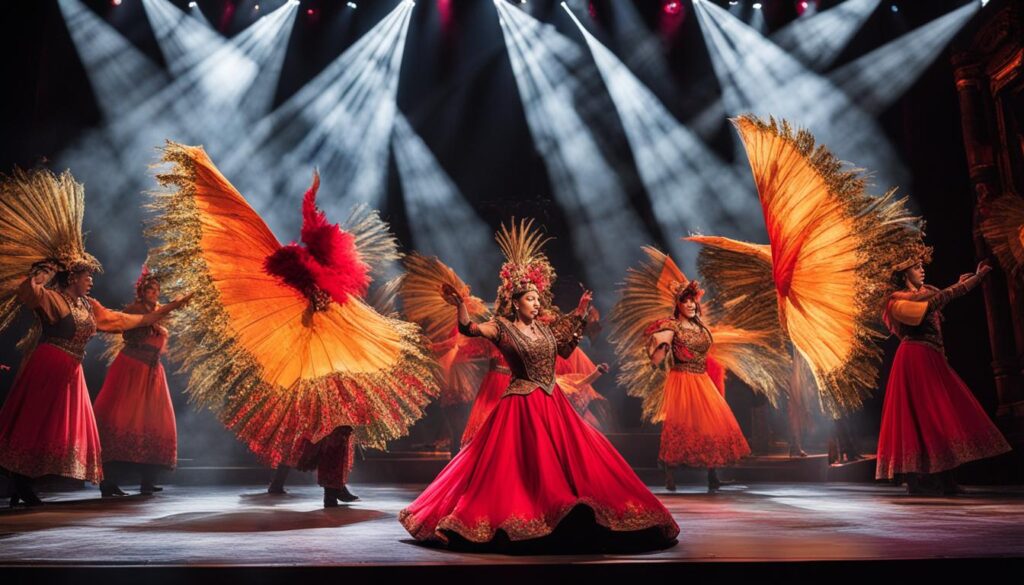

The stage is a catalyst for transformation, a space where the magic of theater turns into palpable energy that surrounds and grips the audience. It’s a medium through which the legacy of Shakespeare lives on, morphing into new forms that challenge our perceptions and heighten our emotions.
Allow me to share with you the intricate dance between actor and audience, the shared breaths during poignant moments, and the thunderous applause that echoes long after the curtains close. It’s this magic that ensures theater remains an enduring pillar within the performing arts, always renewing itself, always ready to tell another story.
Moving to the Rhythm: The Art of Dance
Dance has always fascinated me as a vibrant way to express emotion and tell stories. From heart-pounding dance performances at pulsating theaters to the hushed awe of a ballet stage, the world of dance is incredibly diverse. As a spectator, I’ve been lucky enough to witness a range of dancing styles, each with its own unique charm and technique, truly reflecting the boundless creativity humans are capable of.
Take, for instance, the precise and disciplined world of ballet. Ballet requires years of rigorous training to master the intricate choreography, yet when performed, it seems effortless and graceful. Contrast that with a free dance style where the performers exude spontaneity, allowing the music to move them in the moment, crafting an unpredictable and thrilling experience.
- Traditional dance forms carry with them the heritage and stories of cultures from around the globe.
- Choreography, the intricate crafting of dance movements, turns performers into visual storytellers.
- In both ballet and free dance styles, every movement is a word, every sequence a sentence in the rich narrative of the performance.
For me, the vitality of dance lies in its ability to connect us. Whether I’m watching a traditional dance that has been handed down through generations or a contemporary piece that pushes the boundaries of movement, the language of dance is universal. And with each spectacle, choreographers and dancers keep this language alive and evolving.
Understanding dance means embracing its rich history and its powerful present. Regardless of the form—be it classical ballet with its storied legacy or modern dance that often reflects current realities—the power of dance to move, to connect, and to tell our collective human story remains unmatched. And that’s a rhythm I’ll always move to.
Harmony and Melody: Exploring Music Performances
For me, music is the beat of the soul, bringing together notes and melodies to create a story that speaks to each of us. There’s nothing quite like experiencing music live, feeling the vibrations in the air, and being part of a crowd that’s united by rhythm and sound.
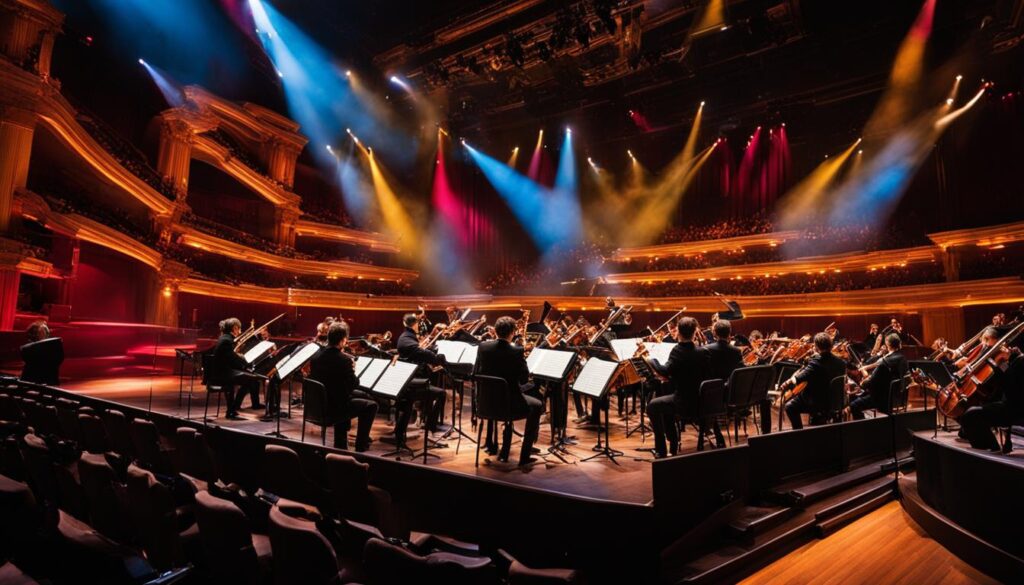

Musical Genres: A Symphony of Styles
When it comes to musical genres, my taste is as varied as the genres themselves. There are instances when the smooth and improvisational riffs of jazz perfectly accompany a laid-back evening. Then, there are days when the structured complexity of classical music brings a sense of calm to the chaos of life. Additionally, the infectious beats of hip hop can energize even the most mundane tasks. With such a wealth of music performances, coming across a new favorite style is always around the corner.
Concerts and Orchestras: Music as a Shared Experience
I believe that live music, whether it’s in an intimate club or a grand concert hall, creates a bond between us that transcends the ordinary. The collective energy of a crowd, the shared enthusiasm shown in each synchronized clap, and the reverent hush that falls as an orchestra begins to play; these moments craft an unforgettable shared sonic journey.
- Intimate concerts in cozy venues where each note resonates with a personal touch.
- Immersive music festivals showcasing the diversity of music and bringing together fans from all walks of life.
- Grand orchestras breathing life into timeless compositions, reminding us that some experiences are best shared.
These forms of live music stand as testaments to the enduring power of communal listening and the unifying language of melodies and harmonies. For me, music is not just an auditory experience—it’s a journey we embark on together, one song at a time.
Where Bodies and Objects Speak: Mime, Puppetry, and Circus Arts
As a lover of the performing arts, I have always been captivated by the sheer magic of live entertainment. There is something utterly enchanting about watching a performance unfold right before my eyes, whether it’s on a bustling street corner or within the grand tent of a circus. Today, I want to take you through the fascinating worlds of mime, puppetry, and circus arts—disciplines that remind us that words aren’t the only way to weave stories and evoke emotions.
Think of mime as the art of the invisible; mimes use their body as a canvas to paint a picture so vivid, you forget there’s nothing actually there. It’s a testament to the power of non-verbal storytelling, where every gesture and expression counts. Then there’s puppetry, an ancient art that brings inanimate objects to life, each puppeteer a creator playing god to their miniature creations, enchanting young and old alike.
- Mime: A silent tale told through movement and expression
- Puppetry: Animated storytelling with crafted figures
- Circus Arts: A thrilling combination of acrobatics, clowning, and daredevil stunts
Not to be outdone, circus arts are, without a doubt, one of the most dynamic forms of street performance and live entertainment. Imagine the gasps and applause as acrobats defy gravity, clowns bring laughter, and jugglers execute flawless throws and catches—all contributing to the rich tapestry of the circus tradition. What ties all these art forms together is their ability to connect with people from all walks of life, leaving behind an indelible mark of wonder and joy.
From the quiet intensity of a mime to the joyous spectacle of the circus, these performing arts ensure that even without a spoken word, the story is heard loud and clear. It’s this boundless ability to communicate and entertain that keeps me enamored with the captivating world of puppetry, mime, and circus arts.
Across the Globe: Traditional and Modern Performing Arts
As I explore global performing arts, I’m continually amazed by the kaleidoscope of creativity that spans the entire planet. From the traditional performances that have stood the test of time to modern expressions that challenge the status quo, performing arts have an incredible capacity for cultural promotion and uniting people. Street theatre, a vivid example of performing arts accessibility, can transform any public space into a stage, proving that art doesn’t need to be confined to grand venues to be influential.
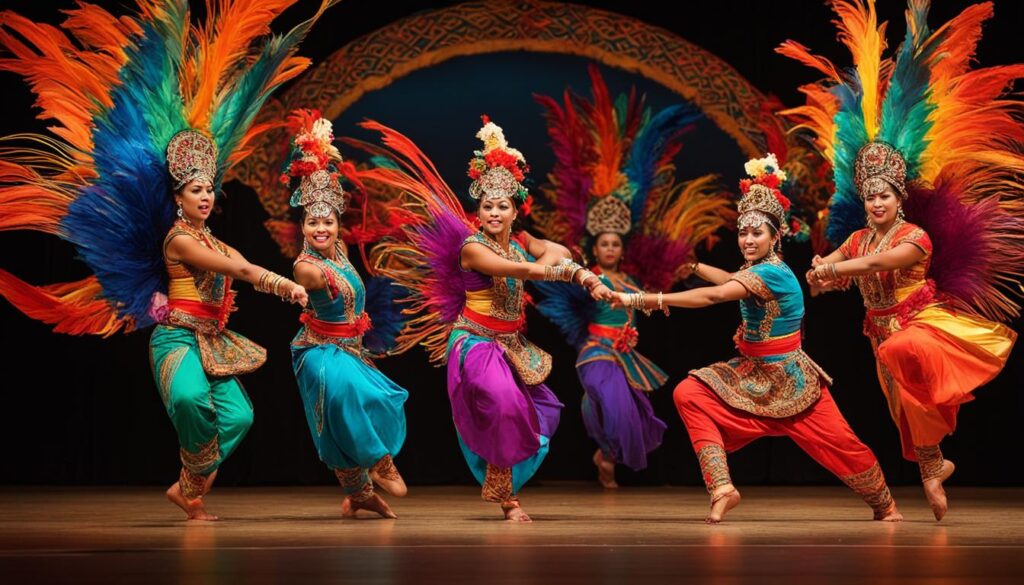

In my journey, I’ve encountered magnificent traditional dances that have been the heartbeat of communities for centuries, and modern performances that mirror our dynamic societies. This rich diversity not only entertains but fosters a deeper understanding among cultures, erasing borders and creating a shared language of emotion and storytelling.
World Music and Dance: Uniting Cultures Through Performance
The rhythm of world music and the grace of dance are universal languages that speak directly to the soul. I’ve seen firsthand how these art forms can bridge gaps and create connections, making them invaluable tools for cultural exchange and cohesion.
The Evolution of Performance Art: Breaking Boundaries
In the realm of modern performances, artists are constantly pushing boundaries, redefining what it means to express and connect. Through my experiences with contemporary art forms, it’s clear that the evolution of these performances is as boundless as the creativity of the human spirit, a testament to the ever-changing nature of how we share and celebrate our cultures.
Conclusion: The Cultural Echo of Performing Arts
In my journey exploring the profound and vibrant world of performing arts, I’ve witnessed how it exemplifies a reflection of humanity, with each live performance knitting a delicate tapestry of cultural heritage and human expression. It’s a realm where the heartbeat of tradition throbs alongside the pulse of innovation, endlessly sketching the vast contours of our social landscape.
Performing Arts as a Reflection of Humanity
Standing in the footlights of history, performing arts chronicle our tales of joy, despair, and triumph. This art form captures the spectrum of emotions that shape our existence and amplifies them through stirring spectacles of dance, theater, and music. The raw power of a ballerina’s leap, the emotive deliverance of an aria, or the soul-stirring dialogue in a play—all are mirrors to our inner worlds.
The Ever-Changing Landscape of Live Performances
Harnessing the essence of the ever-moving performing arts evolution, I’ve observed and partaken in the conversation between artist and audience—a dialogue that’s perpetually being reinvented. As I look toward the horizon, it’s clear that the cultural currency of live performances remains invaluable. They are not mere entertainments; they are cornerstones of our identity, legacy, and shared global culture. As they adapt to the rhythms of our time, they ensure that the story of us—our past, present, and future—continues to be told with fervor and finesse, echoing through the ages.
FAQ
What is the definition of performing arts?
Performing arts refer to forms of creative expression that are performed live before an audience. This encompasses a wide range of artistic disciplines, such as theater, dance, music, opera, mime, and circus skills. It involves the live presentation of art by performers, from actors and musicians to dancers and singers, focusing on the expression of emotions, stories, and cultural narratives.
Can you give examples of performing arts?
Sure, some examples of performing arts include a Shakespearean play performed at a theater, a ballet recital, an opera performance at a grand opera house, a symphony orchestra concert, street dance performances, magic shows, contemporary dance pieces in a studio, and live bands playing at a music venue or festival.
What are the different types of performing arts?
There are numerous types of performing arts spanning various genres and cultural traditions. Notable types include theater arts, dance performances, and music performances. Each category can be further broken down into sub-genres, such as opera and ballet within theater arts; traditional, modern, and free dance styles in dance performances; and an array of musical genres like classical, jazz, rock, and many more in music performances.
How do the performing arts impact culture?
The performing arts play a significant role in conveying cultural heritage, shaping societal norms, and fostering interaction among different cultures. They can reflect societal changes, influence public sentiment, and provide a platform for discussing contemporary issues. Additionally, the performing arts can preserve traditions while also providing a means for innovation and change within cultures.
How did the performing arts begin?
The history of performing arts can be traced back to ancient civilizations. Greek tragedies, which incorporated elements of dance, and the comedic spectacles of Roman farces mark early examples. These art forms have evolved through various periods of history, drawing from enduring traditions and adapting to new influences along the way.
How has theater developed over the years?
Theater has seen dramatic evolution from its origins in ancient ceremonies to the elaborate productions of today’s Broadway scene. From the classic works of Shakespeare to contemporary plays and musicals, theater has transitioned through various styles, incorporating innovative technology, diverse storytelling methods, and expanding narratives to reflect and engage current audiences.
What is the significance of dance in performing arts?
Dance is a fundamental aspect of performing arts, offering a visceral form of expression through movement. It’s a versatile art form that spans entertaining spectacles, like ballet, and also serves ritual and storytelling purposes in many cultures. Dance can capture emotions, depict narratives, and even serve as a form of social commentary or historical record.
What types of music performances are there?
Music performances are incredibly varied, covering genres such as classical, pop, rock, and jazz, occurring in settings ranging from intimate local venues and bustling street corners to grand concert halls and festivals. Performances can include a solo singer-songwriter, a choir, a rock band, electronic music DJs, or a full symphony orchestra, each providing unique auditory experiences for audiences.
What are some less traditional forms of performing arts?
Apart from the well-known forms like theater, dance, and music, performing arts also include less traditional forms such as mime, which tells stories through silent gesture; puppetry, which uses crafted figures to entertain and educate; and circus arts, which combine acrobatics, clowning, and other skills to create a dynamic visual spectacle.
How are global performing arts important for cultural unity?
Global performing arts are crucial in celebrating cultural diversity and fostering unity. They act as a cross-cultural language that can bridge gaps between different societies. By experiencing the performing arts from various parts of the world, people can gain insights into other cultures, traditions, and perspectives, promoting a shared sense of humanity and understanding.
How has performing arts evolved to reflect societal changes?
Performing arts continue to evolve by adapting to new technologies, shifting social norms, and cultural dynamics. This evolution can be seen in the incorporation of multimedia in theater productions, the fusion of dance styles, and the use of music as a platform for social activism. As society changes, so too does the way its stories are told through the performing arts, ensuring that this art form remains a relevant and vital means of expression and reflection.
